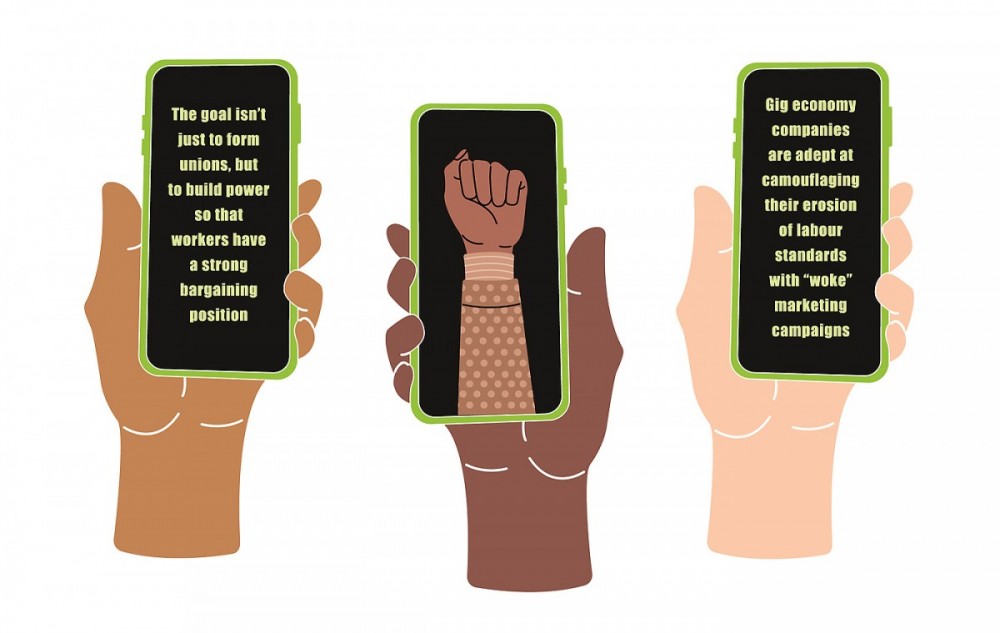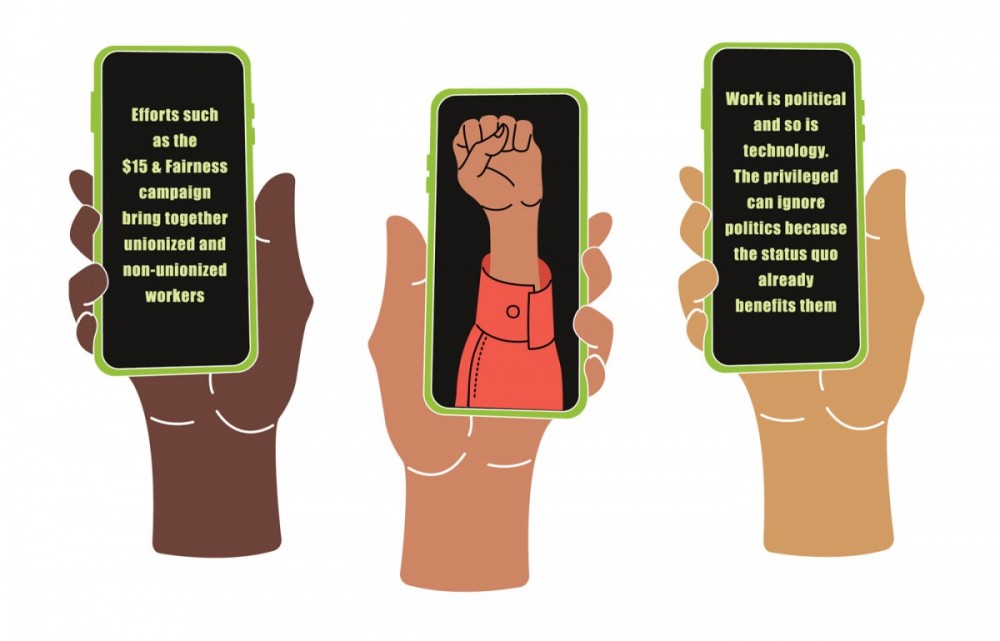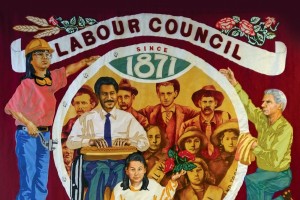Consider this thought: what would happen if tech entrepreneurs saw unions as not just obstacles to the exploitation of workers, but as a potential new market?
Apps like Uber, Lyft, DoorDash and Instacart quickly became major players in urban transit and food delivery with the help of venture capitalists. As they tell it, they upended the established order by offering consumers a seamless, easy-to-use service.
In reality, their business model has less to do with innovation than with evading regulation and growing their market share at any cost. Uber is able to lose billions of dollars a year thanks to the deep pockets and patience of its investors. The company’s backers are betting on a future where Uber becomes the primary way to meet our transportation and delivery needs.
In November 2020, gig economy companies demonstrated their growing power and influence via U.S. legislation that formalized their classification of gig workers as independent contractors. App companies collectively spent USD $200 million on a campaign to support the passage of Proposition 22 in California, a ballot measure which overrode landmark legislation protecting the employment rights of gig workers.
Uber’s independent contractor model faced a major setback this February when the UK Supreme Court ruled that rideshare drivers are in fact workers who are entitled to receive minimum wage for all of their working time, as well as holiday pay and pension contributions. However, Uber has not let up on their intensive lobbying strategy. In March they announced an effort to persuade Canadian provinces to enact legislation similar to Proposition 22, drawing the ire of gig workers who vowed to fight it.
Opportunities and threats
According to the Trades Union Congress (TUC) in the United Kingdom, the labour movement could be “vulnerable to disruptive new entrants coming into our space.” Earlier this year, the TUC released a report that highlighted the risk of disruptive innovation to unions that are unresponsive to the changing realities of work. We should heed TUC’s warning in Canada and the United States as well.
If unions fail to offer workers a vision beyond the idea of a union as a service — simply a passive form of insurance that you can enroll in — a slick new alternative might strike current or prospective union members as a compelling option.
Unions can differentiate themselves by breaking with the top-down model of “business unionism.” This service-oriented approach tends to limit its advocacy to bread-and-butter issues of wages and benefits for existing union members, while allowing them few opportunities for meaningful participation. More and more functions of the union are concentrated in the hands of professionalized staff and a small group of elected leaders.
Instead of narrowing our horizons, unions need to present a compelling vision of how we intend to build power for all workers: high-participation, worker-led campaigns, bargaining for the common good, and investing in organizing the unorganized, which will necessarily involve developing effective digital strategies.
Experimenting with digital-first organizing
The idea of digital disruption in the “union space” isn’t just a thought experiment. One recent entrant in the growing market of software-as-a-service products geared towards the labour movement proposes to cut out the “middleman” entirely.
Unit of Work is a U.S.-based platform that aims to help workers organize and collects dues in exchange for providing its service. A public-benefit corporation, it is for-profit, but its decisions are also guided by its mission to support workers’ rights.
Unit calls itself a “worker-side labour consultancy.” Founder James White described Unit of Work to Our Times as the “the pro-union equivalent of union busters” — the hired guns that employers bring in to keep unions out.
White is a relative newcomer to the labour movement. As a grad student at MIT, he volunteered with a Justice for Janitors campaign on campus during the emergence of the Occupy movement in 2011. After graduating he worked for a medical devices start-up, though he maintained an interest in labour issues and a desire to use technology to make unionization more accessible and efficient.
In May of 2020, after raising USD $800,000 in private funding, Unit of Work advertised a job on the Union Jobs website for a lead organizer who, working either remotely or in New York City, would focus on small and medium workplaces. The position offered an annual salary of USD $80-120,000.
Citing half-hearted efforts by traditional unions to reach young workers online, labour reporter Hamilton Nolan welcomed Unit’s arrival, noting that “the labour movement could certainly use as much tech competence as it can get.”
The app is still in its early stages. White told Our Times that they are currently testing Unit in worksites with less than 200 employees as a tool to organize and sign electronic membership cards. Based on this on-the-ground learning, Unit has already needed to recalibrate its approach.
The process, outlined in a video on an earlier iteration of their website, was smooth to the point of being nearly frictionless. “Want to change something about your workplace?” asks the narrator, who then goes on to suggest that creating change is as simple as first anonymously inviting co-workers to discuss workplace issues via the app, then voting to form an “independent union” to gain access to legal rights and protections, before improving your workplace with guidance from Unit’s experts on “good faith negotiation” with your employer.

Joining a union should be this painless, but it isn’t. Anti-union employers and politicians have made it very difficult for workers to form legally recognized unions. Election processes are often subject to mandatory anti-union “captive-audience” meetings, threats, unlawful behaviour and drawn-out legal challenges by employers.
A smoother, digital-first approach might make it easier to secure union certification but could leave workers unprepared for the inevitable fight that will follow. If their primary engagement with each other comes via a group chat in an app and the signing of an electronic membership authorization card, workers may come out of the process without any real capacity to take collective action, which is the only leverage they have to win the changes they want to see in their workplace.
Negotiations are almost never in “good faith” because employers have no interest in taking direction from their employees. That’s why our goal isn’t just to form unions, but to build power so that workers have a strong bargaining position. We do this through worker-led campaigns that focus on using deep organizing skills such as workplace mapping, identifying leaders, having one-on-one conversations, and creating actions that demonstrate the growing strength of a group of workers.
Jane McAlevey provides a detailed guide to this approach in her books — including the aptly named No Shortcuts — and online trainings with the Rosa Luxemburg Foundation. She emphasizes the importance of robust worker-to-worker organizing strategies that build unity through difficult conversations and an escalating series of high-participation actions involving a super majority of workers.
Unit of Work’s White was quick to acknowledge that developing relationships is central to effective organizing and building worker power. “We found that the anonymous approach is a good method to seed a workplace initially — but we realized that it’s a bad method to grow from 20 per cent to 80 per cent of cards,” said White. “Now, when we see activity on the app, and that they are starting to make progress, we have a real-life organizer reach out, as part of a blended model, and this is working quite a bit better.”
Perhaps counterintuitively, so far Unit has received more interest from blue-collar workers than techies, who you might think are more accustomed to using apps. In response to suggestions from workers, White is looking to include additional features to assist with workplace mapping and to enable more collaboration via polls and forums.
Digital raiding?
As a former staffer with an organizing-oriented union, I must confess that some of Unit’s early messaging raised red flags. I’ve seen these talking points before in the context of raids, which are campaigns engineered to capture the existing membership of another union.
Unions pop up — or are propped up — from time-to-time with this express purpose in mind. These campaigns tend to be waged from the right. They appeal to the grievances of members, such as a lack of responsiveness or accountability from their union leadership, while promoting a hollow vision of trade unionism. In their efforts to woo potential members, these pseudo-unions typically highlight their lower dues, independence from broader labour federations, and lack of involvement with political issues.
For example, in a recent raid on an established healthcare union at a Toronto hospital, the upstart National Organized Workers Union (NOWU) — the second such body created by a former SEIU staffer — circulated a leaflet trumpeting their “cheaper union dues,” greater “control and choices for the members,” and “less wasted dues” due to their independence.
Similarly, in the FAQ section on an earlier version of its website, Unit highlighted that its dues rate of 0.8 per cent was “much less” than average because it is not part of a larger national union and does not earmark any funds for political campaigns.
Unit of Work unions can vote to increase their dues if they wish to raise funds for their own activities beyond the core services offered by the platform. White also emphasized that workers have the ability to leave Unit at any time and join a traditional union if they so choose.
Unit has moved away from messaging that undercuts existing unions, but other contenders may try, particularly those already initiated into the tradition of raiding. Such campaigns may even take a progressive posture. Gig economy companies have proven quite adept at camouflaging their erosion of labour standards with “woke” marketing campaigns that focus on how they empower women and racialized workers.
Meeting rising expectations
The Trades Union Congress (TUC) in the UK created a Digital Lab to help unions develop new approaches to meet workers’ needs. “We know unions are the best and most sustainable route to building worker power, but if working people perceive other options as better fitting the ways they naturally work, everyone stands to lose,” wrote TUC’s Digital Manager John Wood.
England and Wales have an “open shop” trade union model, which exists in many parts of the United States as well. This means that membership is a choice rather than being automatically extended to workers in a workplace where employees have previously voted to form a union.
A newly hired school teacher in London can decide which union they want to join, or whether they want to join a union at all. The open shop creates a “free rider” problem as non-unionized hires directly benefit from collective bargaining efforts without contributing towards the costs. This, of course, is by design. It is the politics of anti-unionism manifested in law.

Here in Canada, Alberta Premier Jason Kenney is attempting to replicate one aspect of this model by requiring workers to opt in when it comes to supporting the political activities of their unions. Distinguishing between workers having a voice inside and outside of their workplaces is a false divide, though, meant only to reduce working-class people’s influence over decisions that shape their lives.
When union campaigns are successful, they tend to be member-backed initiatives that mobilize thousands around workplace issues or broader community concerns such as the #MeToo, Black Lives Matter and Idle No More movements. Efforts such as the $15 & Fairness campaign are notable for bringing together unionized and non-unionized workers. Kenney’s effort to limit these kinds of activities says something about their power.
Since 2011, a self-styled teachers’ union alternative called Edapt has tried to convince education workers in England and Wales to subscribe to their for-profit casework and legal support service. This “apolitical and independent” organization was created by John Roberts, a 26-year-old former assistant headteacher (the equivalent of a vice-principal) to cater to teachers put off by industrial action and politics.
Edapt received a ringing endorsement from Michael Gove, a Conservative politician who was Education Secretary at the time, and no fan of traditional teachers’ unions due to their tendency to go on strike for better working and learning conditions
Doubling down on reps, not tech?
Eth Morgan and John Chadfield were invited by the TUC Digital Lab to work with one of their affiliates, the Royal College of Midwives (RCM). Morgan, a software engineer, and Chadfield, a product manager, are tech workers with a keen interest in trade unionism. They are both members of the London chapter of the Tech Workers’ Coalition.
The RCM was struggling to maintain up-to-date member data. They were losing touch with members as those members transitioned from higher education into the workforce, to different employers, or when they took maternity leave or experienced other breaks in their employment.
Through a collaborative design process, the conversation within the union shifted from “What big solution can we buy?” to “How can we improve our member data by empowering workplace reps?” This more human-centred approach recognized the potential to build on existing touch points between members and their rank-and-file workplace stewards.
“Reps already know what’s going on in their workplace, who’s new and who’s soon to leave. Connecting them in the simplest and most direct way possible with the union’s dedicated member-services team seemed like an area where technology could enhance human networks rather than replace them,” wrote Morgan and Chadfield in a post on the TUC Digital Lab website. Another benefit of this approach is that reps can leverage these relationships towards complementary goals like increasing member engagement.
Some unions have revamped their membership services by making a centralized member resource centre their primary point of contact. “If you remove localized cultural knowledge, outcomes are going to be poorer for everyone,” Chadfield told Our Times. The unpaid and underappreciated workplace stewards are the heart and soul of many union locals. Rather than recommending an expensive software tool like Salesforce, Morgan and Chadfield suggested that the RCM start by testing the simplest solution that was as hassle-free as possible for busy workplace reps.
However, low-friction solutions still must align with the core values of unions. Morgan and Chadfield are highly critical of the Edapt model. “Unions are political by nature. Work is political and so is technology. Only the most privileged can ignore politics because the status quo already benefits them,” said Chadfield.
“A union is not a business, and trying to apply a business logic to a union is unlikely to work,” added Morgan. “Businesses aim for standardization and automation. If your customers want the same things, it’s easier to mass produce. If customers use the automated checkout, that reduces staffing costs. However, human-to-human relationships are not standard and uniform. You can’t automate that and you can’t outsource that level of caring about the end result.”

Despite their skepticism towards the profit-driven tech industry, both see opportunities for unions to work more efficiently, particularly when it comes to streamlining back-end administrative functions that are repetitive or still involve pen-and-paper hard copies. Morgan and Chadfield believe unions need to do more to reach workers online and to better integrate digital strategies in organizing campaigns.
“The big challenge in modern trade unionism is that we’re still working with organizing models and structures developed for factories, when the realities of what work looks like have changed a great deal,” said Chadfield.
When unions make efforts to adapt, the results can be powerful. During the 2018 strike by CUPE 3903 education workers against York University, the so-called “8th line” played a crucial role according to former executive committee member Mariful Alam. Working in concert with the seven physical pickets, the 8th line was responsible for the digital picket line. Getting their union’s national office to recognize this work as eligible for strike pay took some effort, but doing so ensured the inclusion and active participation of members who were not able to be on the physical picket line due to reasons such as disabilities.
These members took a lead role in the public social media campaign, which has grown increasingly important with education-sector labour disputes that affect tens of thousands of students and their families. When the employer maneuvered to push a forced ratification vote to end the strike, 8th liners were part of a successful effort to win the vote by reaching out by phone to thousands of members for one-to-one conversations.
An online welcome mat for the labour movement
Coworker.org is an example of “worker tech” that is attempting to address the changing nature of work and workplace organizing in the United States. On the surface, Coworker looks like any other e-petition website. The difference is that it was developed by former union staff, with the labour movement specifically in mind.
Coworker supports non-union workers by helping them form online networks to strengthen their collective voice. Workers at Uber, Starbucks and the grocery store chain Publix have run campaigns on Coworker and seen successes like reversing Starbuck’s policy against visible tattoos and dyed hair, lifting Publix’s ban on beards and goatees, and pressuring Uber to add in-app tipping.
After a petition campaign runs its course, the list of supporters remains accessible to workplace organizers for future actions. This opens up new possibilities: worker leaders can use the website to initiate surveys to refute claims made by employers about workplace safety and employee morale. In the public relations battle in California over Proposition 22, for example, gig-employer platforms retained an upper hand because of their monopoly on “official” data, which allowed them to spin narratives that were more favourable to their business interests.
Coworker co-founder Michelle Miller hopes these new networks will help seed the soil for deeper organizing efforts. During a webinar hosted last spring by the non-profit research institute Data & Society, Miller said that Coworker’s philosophy isn’t rooted in the idea that digital tools are somehow superior, rather they are an important addition to our existing repertoire. Online platforms are another way to make organizing accessible.
"It's accessibility that is actually the thing that is going to create a mass movement of workers and shift power in this economy," said Miller during the event. "And that is both in-person, on-the-ground organizing, and organizing online.
"Of course, what we know now about social platforms is that there are a lot of governance issues that have to go into maintaining those as safe spaces for people of colour to organize and women to organize," she added. "But fundamentally if we understand [online] spaces as places for people to assert their demands and have agency over their organizing, it helps us build a vibrant labour movement that has a lot more people in it, which is how we win."
Organizing within and beyond the pandemic
Online organizing became even more important with the onset of the COVID-19 crisis. Since last March, over 250 new campaigns — mostly focusing on COVID-related workplace issues — with more than 300,000 total participants have been initiated on Coworker.
Union organizer Aminah Sheikh was in the middle of a union drive with a group of precariously employed early childhood educators (ECEs) in the Halton Region of Ontario when the pandemic hit. She and the worker committee thought they might have to put their campaign on hold. When they tested the waters with an initial Zoom call, the unprecedented turnout convinced them that they were gaining rather than losing momentum.
Workers managed to build deeper relationships while remaining physically distant by adapting their organizing strategies to a remote context. They focused on one-on-one conversations to win over their undecided colleagues, and hosted large online meetings to build a sense of unity. The ECEs won with a nearly unanimous 99 per cent “yes” vote, which meant that 126 of the 127 ballots cast online were in favour of unionizing with the Elementary Teachers’ Federation of Ontario.

Sheikh’s next campaign with ECEs in Brantford was more difficult. It was her first campaign that took place entirely online and with digitally authorized membership cards to meet the threshold for securing a vote. The group was one third the size of the Halton ECEs, but Sheikh found that it was harder to build relationships online from scratch, particularly three months into the pandemic, as many workers had to find other employment to pay their bills.
The Brantford ECEs won their union vote by a similarly large margin, but Sheikh cautioned that her experiences with digital organizing were just as labour-intensive as the face-to-face variety. “On the day of the vote, we still needed to call people to remind them to vote. There was only a 24-hour window and people are incredibly busy. They might not be checking their work emails. Some people are not that tech savvy. Some people have no internet access or unreliable connections. One worker got locked out of their work email and we had to help them get it sorted out,” said Sheikh.
“I don’t think an app can replace what we do. At the end of the day, everybody is human and some people prefer having a human being explain things to them,” she added.
Effective online organizing is about finding ways to broaden and deepen our connections, and ultimately, to expand our capacity to take collective action. It is not just about modernizing the image of unions or buying expensive ready-made software solutions that make unions function more like businesses.
Whether analog or digital, business unionism is a dead end for the labour movement. Unions can’t turn inwards and adopt a “protect-what-we’ve-got” mentality in response to the latest wave of austerity measures. In this race to the bottom, unions may be surprised to learn that someone else can do what they do — only faster, better and for cheaper.
If we want to innovate, we should build on our unique democratic and egalitarian union cultures. As tech workers Morgan and Chadfield said, “technology could enhance human networks rather than replace them.” Worker-led organizing is our greatest source of strength and what distinguishes us from both top-down corporate power and passive consumerism.
Ryan Hayes is a cultural worker and researcher based in Toronto, where he is a board member with the Mayworks Festival of Working People and the Arts.
If you like what you're reading and want to subscribe, please go here. Thank you!















